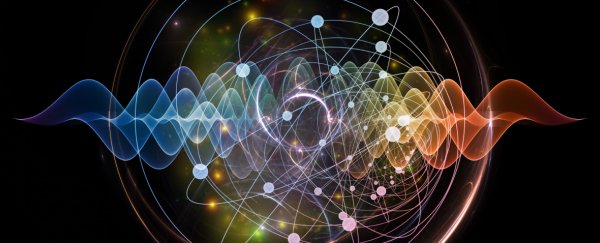Australian scientists have recreated a famous experiment and confirmed quantum physics's bizarre predictions about the nature of reality, by proving that reality doesn't actually exist until we measure it - at least, not on the very small scale.
That all sounds a little mind-meltingly complex, but the experiment poses a pretty simple question: if you have an object that can either act like a particle or a wave, at what point does that object 'decide'?
Our general logic would assume that the object is either wave-like or particle-like by its very nature, and our measurements will have nothing to do with the answer. But quantum theory predicts that the result all depends on how the object is measured at the end of its journey. And that's exactly what a team from the Australian National University has now found.
"It proves that measurement is everything. At the quantum level, reality does not exist if you are not looking at it," lead researcher and physicist Andrew Truscott said in a press release.
Known as John Wheeler's delayed-choice thought experiment, the experiment was first proposed back in 1978 using light beams bounced by mirrors, but back then, the technology needed was pretty much impossible. Now, almost 40 years later, the Australian team has managed to recreate the experiment using helium atoms scattered by laser light.
"Quantum physics predictions about interference seem odd enough when applied to light, which seems more like a wave, but to have done the experiment with atoms, which are complicated things that have mass and interact with electric fields and so on, adds to the weirdness," said Roman Khakimov, a PhD student who worked on the experiment.
To successfully recreate the experiment, the team trapped a bunch of helium atoms in a suspended state known as a Bose-Einstein condensate, and then ejected them all until there was only a single atom left.
This chosen atom was then dropped through a pair of laser beams, which made a grating pattern that acted as a crossroads that would scatter the path of the atom, much like a solid grating would scatter light.
They then randomly added a second grating that recombined the paths, but only after the atom had already passed the first grating.
When this second grating was added, it led to constructive or destructive interference, which is what you'd expect if the atom had travelled both paths, like a wave would. But when the second grating was not added, no interference was observed, as if the atom chose only one path.
The fact that this second grating was only added after the atom passed through the first crossroads suggests that the atom hadn't yet determined its nature before being measured a second time.
So if you believe that the atom did take a particular path or paths at the first crossroad, this means that a future measurement was affecting the atom's path, explained Truscott. "The atoms did not travel from A to B. It was only when they were measured at the end of the journey that their wave-like or particle-like behaviour was brought into existence," he said.
Although this all sounds incredibly weird, it's actually just a validation for the quantum theory that already governs the world of the very small. Using this theory, we've managed to develop things like LEDs, lasers and computer chips, but up until now, it's been hard to confirm that it actually works with a lovely, pure demonstration such as this one.
The full results have been published in Nature Physics.
